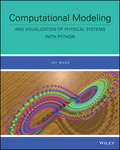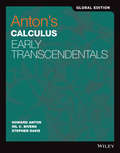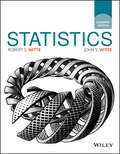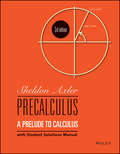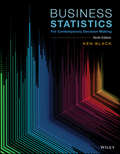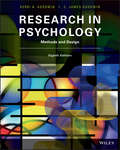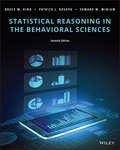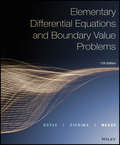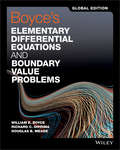- Table View
- List View
Geometry and Symmetry
by L. Christine Kinsey Teresa E. Moore Efstratios PrassidisThis new book helps students gain an appreciation of geometry and its importance in the history and development of mathematics. The material is presented in three parts. The first is devoted to Euclidean geometry. The second covers non-Euclidean geometry. The last part explores symmetry. Exercises and activities are interwoven with the text to enable them to explore geometry. The activities take advantage of geometric software so they'll gain a better understanding of its capabilities. Mathematics teachers will be able to use this material to create exciting and engaging projects in the classroom.
The Foundations of Mathematics
by Thomas Q. SibleyFinally there's an easy-to-follow book that will help readers succeed in the art of proving theorems. Sibley not only conveys the spirit of mathematics but also uncovers the skills required to succeed. Key definitions are introduced while readers are encouraged to develop an intuition about these concepts and practice using them in problems. With this approach, they'll gain a strong understanding of the mathematical language as they discover how to apply it in order to find proofs.
Calculus: Single Variable
by Deborah Hughes-Hallett William G. McCallum Andrew M. Gleason Eric Connally Daniel E. Flath Selin Kalaycioglu Brigitte Lahme Patti Frazer Lock David O. Lomen David Lovelock Guadalupe I. Lozano Jerry Morris Brad G. Osgood Cody L. Patterson Douglas Quinney Karen R Rhea Ayse Arzu Sahin Adam H. Spiegler Jeff Tecosky-Feldman Thomas W. Tucker Aaron D. Wootton Elliot J. MarksWith Wiley’s Enhanced E-Text, you get all the benefits of a downloadable, reflowable eBook with added resources to make your study time more effective, including: • Embedded Example Videos• Built-In Assessments• Interactive Exploration applets• Searchable Appendices & chapter summary reviewsCalculus: Single Variable, 7e continues the effort to promote courses in which understanding and computation reinforce each other. The 7th Edition reflects the many voices of users at research universities, four-year colleges, community colleges, and secondary schools. This new edition has been streamlined to create a flexible approach to both theory and modeling. The program includes a variety of problems and examples from the physical, health, and biological sciences, engineering and economics; emphasizing the connection between calculus and other fields. Calculus: Single Variable, 7e will include Wiley's seamlessly integrated adaptive WileyPLUS ORION program, covering content from refresher Algebra and Trigonometry through Multi-Variable Calculus. Calculus: Single Variable, 7e is the first adaptive calculus program in the market.
Calculus: Multivariable
by Deborah Hughes-Hallett William G. McCallum Daniel E. Flath Andrew M. Gleason Selin Kalaycioglu Brigitte Lahme Patti Frazer Lock Guadalupe I. Lozano Jerry Morris David Mumford Brad G. Osgood Cody L. Patterson Douglas Quinney Ayse Arzu Sahin Adam H. Spiegler Jeff Tecosky-Feldman Thomas W. Tucker Aaron D. Wootton Elliot J. MarksWith Wiley’s Enhanced E-Text, you get all the benefits of a downloadable, reflowable eBook with added resources to make your study time more effective, including: • Embedded Example Videos• Built-In Assessments• Interactive Exploration applets• Searchable Appendices & chapter summary reviewsCalculus: Multivariable, 7e continues the effort to promote courses in which understanding and computation reinforce each other. The 7th Edition reflects the many voices of users at research universities, four-year colleges, community colleges, and secdondary schools. This new edition has been streamlined to create a flexible approach to both theory and modeling. The program includes a variety of problems and examples from the physical, health, and biological sciences, engineering and economics; emphasizing the connection between calculus and other fields. Calculus: Multivariable, 7e will include Wiley's seamlessly integrated adaptive WileyPLUS ORION program, covering content from refresher Algebra and Trigonometry through Multi-Variable Calculus. Calculus: Multivariable, 7e is the first adaptive calculus program in the market.
Introductory Statistics
by Prem S. MannIntroductory Statistics, 9th Edition is written for a one or two semester first course in applied statistics and is intended for students who do not have a strong background in mathematics. The only prerequisite is knowledge of elementary algebra. Introductory Statistics is known for its realistic examples and exercises, clarity and brevity of presentation, and soundness of pedagogical approach.
Introduction to Statistical Investigation
by Nathan Tintle Beth L. Chance George W. Cobb Allan J. Rossman Soma Roy Todd Swanson Jill VanderStoepIntroduction to Statistical Investigations leads students to learn about the process of conducting statistical investigations from data collection, to exploring data, to statistical inference, to drawing appropriate conclusions. The text is designed for a one-semester introductory statistics course.It focuses on genuine research studies, active learning, and effective use of technology. Simulations and randomization tests introduce statistical inference, yielding a strong conceptual foundation that bridges students to theory-based inference approaches. Repetition allows students to see the logic and scope of inference. This implementation follows the GAISE recommendations endorsed by the American Statistical Association.
Statistics: Unlocking the Power of Data
by Robin H. Lock Patti Frazer Lock Kari Lock Morgan Eric F. Lock Dennis F. LockWith Wiley’s Enhanced E-Text, you get all the benefits of a downloadable, reflowable eBook with added resources to make your study time more effective, including: • Embedded & Searchable Tables & Figures• Links to Datasets through wiley.com• Video Solutions & Tutorials• Dataset Index embedded including links to datasets by page numberStatistics: Unlocking the Power of Data, 2nd Edition continues to utilize these intuitive methods like randomization and bootstrap intervals to introduce the fundamental idea of statistical inference. These methods are brought to life through authentically relevant examples, enabled through easy to use statistical software, and are accessible at very early stages of a course. The program includes the more traditional methods like t-tests, chi-square texts, etc. but only after students have developed a strong intuitive understanding of inference through randomization methods. The focus throughout is on data analysis and the primary goal is to enable students to effectively collect data, analyze data, and interpret conclusions drawn from data. The program is driven by real data and real applications.
Elementary Differential Equations
by William E. Boyce Richard C. DiPrima Douglas B. MeadeWith Wiley’s Enhanced E-Text, you get all the benefits of a downloadable, reflowable eBook with added resources to make your study time more effective, including: • Embedded & searchable equations, figures & tables • Math XML• Index with linked pages numbers for easy reference• Redrawn full color figures to allow for easier identificationElementary Differential Equations, 11th Edition is written from the viewpoint of the applied mathematician, whose interest in differential equations may sometimes be quite theoretical, sometimes intensely practical, and often somewhere in between. The authors have sought to combine a sound and accurate (but not abstract) exposition of the elementary theory of differential equations with considerable material on methods of solution, analysis, and approximation that have proved useful in a wide variety of applications. While the general structure of the book remains unchanged, some notable changes have been made to improve the clarity and readability of basic material about differential equations and their applications. In addition to expanded explanations, the 11th edition includes new problems, updated figures and examples to help motivate students. The program is primarily intended for undergraduate students of mathematics, science, or engineering, who typically take a course on differential equations during their first or second year of study. The main prerequisite for engaging with the program is a working knowledge of calculus, gained from a normal two�] or three�] semester course sequence or its equivalent. Some familiarity with matrices will also be helpful in the chapters on systems of differential equations.
Computational Modeling and Visualization of Physical Systems with Python
by Jay WangComputational Modeling, by Jay Wang introduces computational modeling and visualization of physical systems that are commonly found in physics and related areas. The authors begin with a framework that integrates model building, algorithm development, and data visualization for problem solving via scientific computing. Through carefully selected problems, methods, and projects, the reader is guided to learning and discovery by actively doing rather than just knowing physics.
Differential Equations with Matlab
by Brian R. Hunt Ronald L. Lipsman John E. Osborn Jonathan M. RosenbergA supplemental text that can enrich and enhance any first course in ordinary differential equations This supplement helps instructors move towards an earlier use of numerical and geometric methods, place a greater emphasis on systems (including nonlinear ones), and increase discussions of both the benefits and possible pitfalls in numerical solution of ODEs. By providing an introduction to the software that is integrated with the relevant mathematics, Differential Equations with MATLAB can perfectly complement and enhance other texts from Wiley.
Anton's Calculus Early Transcendentals
by Howard Anton Irl C. Bivens Stephen DavisAnton's Calculus, Early Transcendentals strives to increase student comprehension and conceptual understanding through a balance between rigor and clarity of explanations, sound mathematics, and excellent exercises, applications, and examples. Anton pedagogically approaches Calculus through the Rule of Four, presenting concepts from the verbal, algebraic, visual, and numerical points of view.
Mann's Introductory Statistics
by Prem S. MannMann's Introductory Statistics is written for a one or two semester first course in applied statistics and is intended for students who do not have a strong background in mathematics. The only prerequisite is knowledge of elementary algebra. Introductory Statistics is known for its realistic examples and exercises, clarity and brevity of presentation, and soundness of pedagogical approach.
Trigonometry
by Cynthia Y. YoungTrigonometry, 4th Edition brings together all the elements that have allowed instructors and learners to successfully "bridge the gap" between classroom instruction and independent homework by overcoming common learning barriers and building confidence in students' ability to do mathematics. Written in a clear voice that speaks to students and mirrors how instructors communicate in lecture, Young's hallmark pedagogy enables students to become independent, successful learners. Varied exercise types and modeling projects keep the learning fresh and motivating. Young continues her tradition of fostering a love for succeeding in mathematics by introducing inquiry-based learning projects in this edition, providing learners an opportunity to master the material with more freedom while reinforcing mathematical skills and intuition.
College Algebra
by Cynthia Y. YoungWith Wiley’s Enhanced E-Text, you get all the benefits of a downloadable, reflowable eBook with added resources to make your study time more effective, including: • Concept Check Questions• Searchable Learning Objectives• Applications to Business, Economics, Health Sciences and MedicineCynthia Young’s College Algebra, Fourth Edition will allow students to take the guesswork out of studying by providing them with a clear roadmap: what to do, how to do it and whether they did it right, while seamlessly integrating to Young’s learning content. College Algebra, Fourth Edition is written in a clear, single voice that speaks to students and mirrors how instructors communicate in lecture. Young’s hallmark pedagogy enables students to become independent, successful learners. Varied exercise types and modeling projects keep the learning fresh and motivating. This text continues Young’s tradition of fostering a love for succeeding in mathematics.
Algebra and Trigonometry
by Cynthia Y. YoungCynthis Young's Algebra & Trigonometry, Fourth Edition will allow students to take the guesswork out of studying by providing them with a clear roadmap: what to do, how to do it, and whether they did it right, while seamlessly integrating to Young's learning content. Algebra & Trigonometry, Fourth Edition is written in a clear, single voice that speaks to students and mirrors how instructors communicate in lecture. Young's hallmark pedagogy enables students to become independent, successful learners. Varied exercise types and modeling projects keep the learning fresh and motivating. Algebra & Trigonometry 4e continues Young's tradition of fostering a love for succeeding in mathematics.
Crossing the River with Dogs: Problem Solving for College Students
by Ken Johnson Ted Herr Judy KyshCrossing the River with Dogs: Problem Solving for College Students, 3rd Edition promotes the philosophy that students learn best by working in groups and the skills required for real workplace problem solving are those skills of collaboration. The text aims to improve students’ writing, oral communication, and collaboration skills while teaching mathematical problem-solving strategies. Focusing entirely on problem solving and using issues relevant to college students for examples, the authors continue their approach of explaining classic as well as non-traditional strategies through dialogs among fictitious students. This text is appropriate for a problem solving, quantitative reasoning, liberal arts mathematics, mathematics for elementary teachers, or developmental mathematics course.
Statistics
by Robert S. Witte John S. WitteDrawing upon over 40 years of experience, the authors of Statistics, 11th Edition provide students with a clear and methodical approach to essential statistical procedures. The text clearly explains the basic concepts and procedures of descriptive and inferential statistical analysis. It features an emphasis on expressions involving sums of squares and degrees of freedom as well as a strong stress on the importance of variability. This accessible approach will help students tackle such perennially mystifying topics as the standard deviation, variance interpretation of the correlation coefficient, hypothesis tests, degrees of freedom, p-values, and estimates of effect size.
Precalculus: A Prelude to Calculus
by Sheldon AxlerSheldon Axler's Precalculus: A Prelude to Calculus, 3rd Edition focuses only on topics that students actually need to succeed in calculus. This book is geared towards courses with intermediate algebra prerequisites and it does not assume that students remember any trigonometry. It covers topics such as inverse functions, logarithms, half-life and exponential growth, area, e, the exponential function, the natural logarithm and trigonometry.
Business Statistics: For Contemporary Decision Making
by Ken BlackBusiness Statistics: For Contemporary Decision Making, 9th Edition continues the tradition of presenting and explaining the wonders of business statistics through the use of clear, complete, student-friendly pedagogy. Ken Black's text equips readers with the quantitative decision-making skills and analysis techniques they need to make smart decisions based on real-world data.
Research in Psychology: Methods and Design
by Kerri A. Goodwin C. James GoodwinAn approachable, coherent, and important text, Research in Psychology: Methods and Design, 8th Edition continues to provide its readers with a clear, concise look at psychological science, experimental methods, and correlational research in this newly updated version. Rounded out with helpful learning aids, step-by-step instructions, and detailed examples of real research studies makes the material easy to read and student-friendly.
Statistical Reasoning in the Behavioral Sciences
by Bruce M. King Patrick J. Rosopa Edward W. MiniumCited by more than 300 scholars, Statistical Reasoning in the Behavioral Sciences continues to provide streamlined resources and easy-to-understand information on statistics in the behavioral sciences and related fields, including psychology, education, human resources management, and sociology. Students and professionals in the behavioral sciences will develop an understanding of statistical logic and procedures, the properties of statistical devices, and the importance of the assumptions underlying statistical tools. This revised and updated edition continues to follow the recommendations of the APA Task Force on Statistical Inference and greatly expands the information on testing hypotheses about single means. The Seventh Edition moves from a focus on the use of computers in statistics to a more precise look at statistical software. The “Point of Controversy” feature embedded throughout the text provides current discussions of exciting and hotly debated topics in the field. Readers will appreciate how the comprehensive graphs, tables, cartoons and photographs lend vibrancy to all of the material covered in the text.
Elementary Differential Equations and Boundary Value Problems, Enhanced eText (Wiley Plus Products Ser.)
by William E. Boyce Richard C. DiPrima Douglas B. MeadeWith Wiley’s Enhanced E-Text, you get all the benefits of a downloadable, reflowable eBook with added resources to make your study time more effective, including: • Embedded & searchable equations, figures & tables • Math XML• Index with linked pages numbers for easy reference• Redrawn full color figures to allow for easier identificationElementary Differential Equations and Boundary Value Problems 11e, like its predecessors, is written from the viewpoint of the applied mathematician, whose interest in differential equations may sometimes be quite theoretical, sometimes intensely practical, and often somewhere in between. The authors have sought to combine a sound and accurate (but not abstract) exposition of the elementary theory of differential equations with considerable material on methods of solution, analysis, and approximation that have proved useful in a wide variety of applications. While the general structure of the book remains unchanged, some notable changes have been made to improve the clarity and readability of basic material about differential equations and their applications. In addition to expanded explanations, the 11th edition includes new problems, updated figures and examples to help motivate students. The program is primarily intended for undergraduate students of mathematics, science, or engineering, who typically take a course on differential equations during their first or second year of study. The main prerequisite for engaging with the program is a working knowledge of calculus, gained from a normal two� or three� semester course sequence or its equivalent. Some familiarity with matrices will also be helpful in the chapters on systems of differential equations.
Elementary Differential Equations and Boundary Value Problems
by William E. Boyce Richard C. DiPrima Douglas B. MeadeWith Wiley’s Enhanced E-Text, you get all the benefits of a downloadable, reflowable eBook with added resources to make your study time more effective, including: • Embedded & searchable equations, figures & tables • Math XML• Index with linked pages numbers for easy reference• Redrawn full color figures to allow for easier identificationElementary Differential Equations and Boundary Value Problems 11e, like its predecessors, is written from the viewpoint of the applied mathematician, whose interest in differential equations may sometimes be quite theoretical, sometimes intensely practical, and often somewhere in between. The authors have sought to combine a sound and accurate (but not abstract) exposition of the elementary theory of differential equations with considerable material on methods of solution, analysis, and approximation that have proved useful in a wide variety of applications. While the general structure of the book remains unchanged, some notable changes have been made to improve the clarity and readability of basic material about differential equations and their applications. In addition to expanded explanations, the 11th edition includes new problems, updated figures and examples to help motivate students. The program is primarily intended for undergraduate students of mathematics, science, or engineering, who typically take a course on differential equations during their first or second year of study. The main prerequisite for engaging with the program is a working knowledge of calculus, gained from a normal two� or three� semester course sequence or its equivalent. Some familiarity with matrices will also be helpful in the chapters on systems of differential equations.
Boyce's Elementary Differential Equations and Boundary Value Problems
by William E. Boyce Richard C. DiPrima Douglas B. MeadeBoyce's Elementary Differential Equations and Boundary Value Problems, like its predecessors, is written from the viewpoint of the applied mathematician, whose interest in differential equations may sometimes be quite theoretical, sometimes intensely practical, and often somewhere in between. The authors have sought to combine a sound and accurate (but not abstract) exposition of the elementary theory of differential equations with considerable material on methods of solution, analysis, and approximation that have proved useful in a wide variety of applications. While the general structure of the book remains unchanged, some notable changes have been made to improve the clarity and readability of basic material about differential equations and their applications. In addition to expanded explanations, this edition includes new problems, updated figures and examples to help motivate students. The program is primarily intended for undergraduate students of mathematics, science, or engineering, who typically take a course on differential equations during their first or second year of study. The main prerequisite for engaging with the program is a working knowledge of calculus, gained from a normal two� or three� semester course sequence or its equivalent. Some familiarity with matrices will also be helpful in the chapters on systems of differential equations.
Boyce's Elementary Differential Equations and Boundary Value Problems
by William E. Boyce Richard C. DiPrima Douglas B. MeadeBoyce's Elementary Differential Equations and Boundary Value Problems, like its predecessors, is written from the viewpoint of the applied mathematician, whose interest in differential equations may sometimes be quite theoretical, sometimes intensely practical, and often somewhere in between. The authors have sought to combine a sound and accurate (but not abstract) exposition of the elementary theory of differential equations with considerable material on methods of solution, analysis, and approximation that have proved useful in a wide variety of applications. While the general structure of the book remains unchanged, some notable changes have been made to improve the clarity and readability of basic material about differential equations and their applications. In addition to expanded explanations, this edition includes new problems, updated figures and examples to help motivate students. The program is primarily intended for undergraduate students of mathematics, science, or engineering, who typically take a course on differential equations during their first or second year of study. The main prerequisite for engaging with the program is a working knowledge of calculus, gained from a normal two� or three� semester course sequence or its equivalent. Some familiarity with matrices will also be helpful in the chapters on systems of differential equations.








